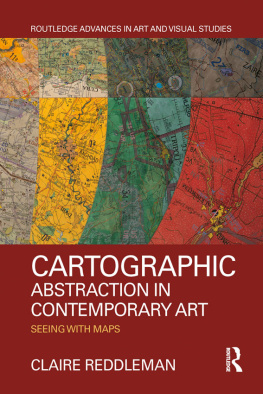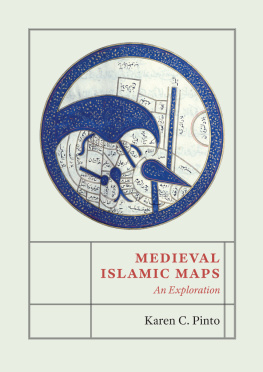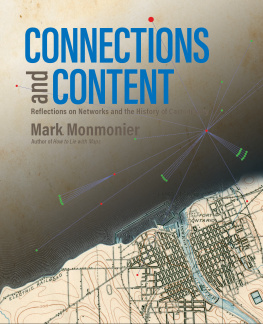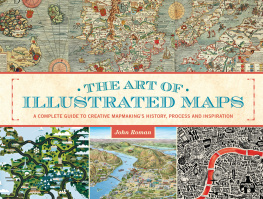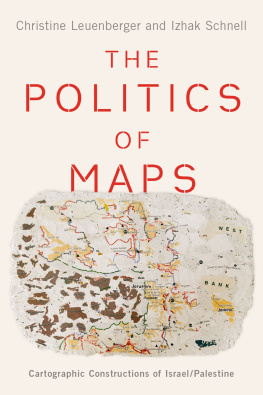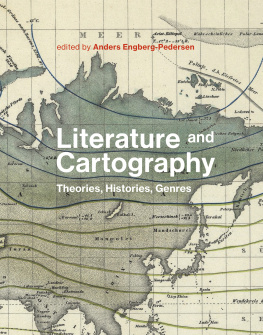Reddleman - Cartographic abstraction in contemporary art: seeing with maps
Here you can read online Reddleman - Cartographic abstraction in contemporary art: seeing with maps full text of the book (entire story) in english for free. Download pdf and epub, get meaning, cover and reviews about this ebook. City: New York, year: 2018;2017, publisher: Routledge;Taylor & Francis Group, genre: Romance novel. Description of the work, (preface) as well as reviews are available. Best literature library LitArk.com created for fans of good reading and offers a wide selection of genres:
Romance novel
Science fiction
Adventure
Detective
Science
History
Home and family
Prose
Art
Politics
Computer
Non-fiction
Religion
Business
Children
Humor
Choose a favorite category and find really read worthwhile books. Enjoy immersion in the world of imagination, feel the emotions of the characters or learn something new for yourself, make an fascinating discovery.
- Book:Cartographic abstraction in contemporary art: seeing with maps
- Author:
- Publisher:Routledge;Taylor & Francis Group
- Genre:
- Year:2018;2017
- City:New York
- Rating:3 / 5
- Favourites:Add to favourites
- Your mark:
- 60
- 1
- 2
- 3
- 4
- 5
Cartographic abstraction in contemporary art: seeing with maps: summary, description and annotation
We offer to read an annotation, description, summary or preface (depends on what the author of the book "Cartographic abstraction in contemporary art: seeing with maps" wrote himself). If you haven't found the necessary information about the book — write in the comments, we will try to find it.
Reddleman: author's other books
Who wrote Cartographic abstraction in contemporary art: seeing with maps? Find out the surname, the name of the author of the book and a list of all author's works by series.
Cartographic abstraction in contemporary art: seeing with maps — read online for free the complete book (whole text) full work
Below is the text of the book, divided by pages. System saving the place of the last page read, allows you to conveniently read the book "Cartographic abstraction in contemporary art: seeing with maps" online for free, without having to search again every time where you left off. Put a bookmark, and you can go to the page where you finished reading at any time.
Font size:
Interval:
Bookmark:

In this book, Claire Reddleman introduces her theoretical innovation cartographic abstractiona material modality of thought and experience that is produced through cartographic techniques of depiction. Reddleman closely engages with selected artworks (by contemporary artists such as Joyce Kozloff, Layla Curtis, and Bill Fontana) and theories in each chapter. Reconfiguring the Foucauldian underpinning of critical cartography towards a materialist theory of abstraction, cartographic viewpoints are theorised as concrete abstractions. This research is positioned at the intersection of art theory, critical cartography and materialist philosophy.
Claire Reddleman received her PhD in cultural studies from Goldsmiths, University of London.
Cartographic visions and the Apollos eye organized, ordered, quantified, and defined the spaces of the modern world. How do we make sense of a contemporary world in which surveillance cameras, drones, and satellites are no longer strange but are our everyday reality? Claire Reddlemans inspired book brings together critical cartographic studies with the work of artists whose creations depend on maps, drones, and related tools. This, the resulting book, generates theoretical tools for grappling with uncertain times.
James Housefield, University of California, Davis
Cover image: Joyce Kozloff, Targets (2000), interior view (detail).
Image credit: The artist & DC Moore Gallery, NY.
For a full list of titles in this series, please visit www.routledge.com
W.J.T. Mitchells Image Theory
Living Pictures
Edited by Kreimir Purgar
The Politics of Contemporary Art Biennials
Spectacles of Critique, Theory and Art
Panos Kompatsiaris
Contemporary Visual Culture and the Sublime
Edited by Temenuga Trifonova
Art, Animals, and Experience
Relationships to Canines and the Natural World
Elizabeth Sutton
What Drawing and Painting Really Mean
The Phenomenology of Image and Gesture
Paul Crowther
The Concept of the Animal and Modern Theories of Art
Roni Grn
The Aesthetics of Scientific Data Representation
More than Pretty Pictures
Edited by Lotte Philipsen and Rikke Schmidt Kjrgaard
Art : Process : Change
Inside a Socially Situated Practice
Loraine Leeson
Visualizing War
Emotions, Technologies, Communities
Edited by Anders Engberg-Pedersen and Kathrin Maurer
Cartographic abstraction in contemporary art
seeing with maps
Claire Reddleman

First published 2018
by Routledge
711 Third Avenue, New York, NY 10017
and by Routledge
2 Park Square, Milton Park, Abingdon, Oxon OX14 4RN
Routledge is an imprint of the Taylor & Francis Group, an informa business
2018 Taylor & Francis
The right of Claire Reddleman to be identified as author of this work has been asserted by her in accordance with sections 77 and 78 of the Copyright, Designs and Patents Act 1988.
All rights reserved. No part of this book may be reprinted or reproduced or utilised in any form or by any electronic, mechanical, or other means, now known or hereafter invented, including photocopying and recording, or in any information storage or retrieval system, without permission in writing from the publishers.
Trademark notice: Product or corporate names may be trademarks or registered trademarks, and are used only for identification and explanation without intent to infringe.
Library of Congress Cataloging-in-Publication Data
A catalog record for this book has been requested
ISBN: 978-1-138-71257-7
ISBN: 978-1-315-20006-4
Typeset in Sabon
by Apex CoVantage, LLC
My thanks go first and foremost to those who supervised me over the course of this project as a PhD at Goldsmiths, University of London: Alberto Toscano, Susan Schuppli and John Hutnyk. At Goldsmiths, I also thank Mary Claire Halvorson, John Levett, Anisha Ahmed, Ian Tucknott, Simon Barber, Philipp Jeandree and Aya Hino.
I would like to thank those who have taken part in various reading groups with me, who have challenged and supported me, and shaped my thinking, as well as those who have taught me in various capacities during my time at Goldsmiths.
My thanks go to the artists, designers and galleries who have kindly given me permission to reproduce their images, and all other persons whose labour has made my work possible.
Particular thanks go to Joel Winder, Sophie Fuggle, Lucy Bond, Chris Jude, Ben Mackay, Henry Lane, Angela Smith, John Canfield, Leen Van Broeck, Emma Leach, and, above all, Edward Mackay.
We see with maps. Using maps to create complex visual understandings of the world is an activity that most of us are so used to that we do not tend to consider how the maps we read help us form these understandings. Map use has become a thoroughly commonplace activity, whether we are navigating in a city using a smartphone, planning a journey across the country, or looking at artworks that include images of maps in an art gallery or on an artists website. The specifically cartographic way in which we create spatial and visual understandings of the world is the subject of this book. I offer a new theoretical framework for understanding how we go about the complex process of seeing with maps. I use this idea of seeing with maps to claim two thingsthat maps are deeply concerned with creating a sense that we can see the world by using them and to assert a commitment to further John Bergers important claim that [o]ur vision is continually active, continually moving, continually holding things in a circle around itself, constituting what is present to us as we are (1972/2008, p. 9). Vision is an active process, constituted by a range of means, including map use, and it is the process of how we see with maps that I focus on here. The cartographic image implies and constitutes its viewer using distinctive visual techniques that can usefully be investigated through considering contemporary artworks that take up, explore and disrupt cartographic ways of seeing (Berger, 1972).
This book proposes a theory of cartographic abstraction as a framework for investigating cartographic viewing and does so through exploring a series of contemporary artworks that are engaged with cartographic abstraction in different ways. I bring together close readings of these artworksby Joyce Kozloff, James Bridle, Trevor Paglen, Layla Curtis and Bill Fontanawith materialist approaches to abstraction. This is an interdisciplinary investigation concerned with enlarging the current possibilities for critically understanding viewing and subjectivity in the area of cartographic imagery. I aim to push beyond the highly productive framework of critical cartography to articulate a new approach to understanding cartographys effects in the world. In order to do this, the new theoretical proposal that I put forward and use throughout this book is cartographic abstraction.
Font size:
Interval:
Bookmark:
Similar books «Cartographic abstraction in contemporary art: seeing with maps»
Look at similar books to Cartographic abstraction in contemporary art: seeing with maps. We have selected literature similar in name and meaning in the hope of providing readers with more options to find new, interesting, not yet read works.
Discussion, reviews of the book Cartographic abstraction in contemporary art: seeing with maps and just readers' own opinions. Leave your comments, write what you think about the work, its meaning or the main characters. Specify what exactly you liked and what you didn't like, and why you think so.

